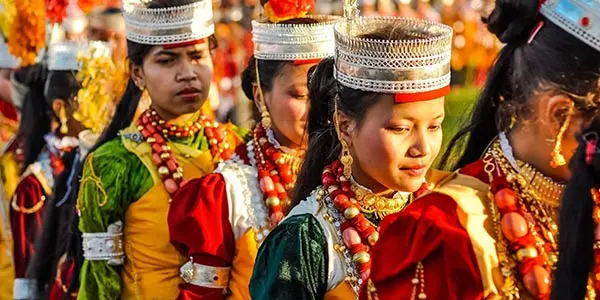Meghalaya, or the abode of clouds, is a hilly state in northeastern India. Folk dance forms and music make up the rich cultural landscape of this state. Dancing is a major part of celebrations in the state for any occasion, such as marriage, birth, festivals, and others. Meghalaya is a tribal state with Khasi, Garo and Jaintia tribes making up the majority. Each tribe has its distinctive dance form. Some of the major folk dances in Meghalaya have been discussed here.
Folk Dance Styles Of Meghalaya
1. Nongkrem

Nongrem dance is a major folk dance form of the Khasi tribe. This is a religious dance because the Khasi tribe dedicates it to their goddess Ka Blei Synshar. They pray to her for good harvest and prosperity through this dance. Nongkrem dance is performed from October to November as part of religious ceremonies at Smit, the capital of Khyrim Syiemship, and near Shillong’s state capital.
Unmarried girls perform nongkrem dance with their male partners. The girls dance forward and backward within a circle while their male partners dance in a wide circle. Female dancers wear colorful costumes and gold and silver ornaments and yellow flowers. The male dancers carry an open sword in one hand and a white yak hair in the other hand.
2. Behdiengkhlam
Behdiengkhlam is one of the major folk dances of the Jaintia tribe. It is performed each year in the month of July during the celebrations of Behdiengkhlam festival. The festival is held before the onset of the monsoon season to pray to the divine for a healthy harvest and to protect the people and crops against diseases and pests. The main location of this dance form is Jowai in Jaintia Hills.
3. Wangala
Wangala dance is an integral part of the Wangala festival of the Garo tribe. Wangala festival is held in autumn after the harvest season. The purpose of the festival is to please the deity Patigipa Rarongipa. A host of ceremonies are held as a part of the festival, which runs for four days and nights.
Wangala dance is performed at the end stage of the festivities. This dance performance is highlighted as the Dance of a Hundred Drums on the festival’s last day. It is a warrior dance that creates an impressive spectacle.
4. Shad Suk Mynsiem
Shad Suk Mynsiem is a traditional Thanksgiving dance of the Khasi tribe which is performed during the month of April as a part of the festivities, which run for three days. The dance is performed in the Khasi hills, and its purpose is to celebrate the planting and harvesting season. The participants of the dance are unmarried men and women.
Shad Suk Mynsiem entails women in groups of 2-3 dancing in an inner circle while men carrying swords and spears dance in an outer protective circle. The male dancers wear colorful silk dhotis, coats, and turbans, while the female dancers wear visually appealing silk robes. Flutes and drums generate the musical tones.
5. Laho
Laho is a traditional dance form of the Pnar tribe, which both men and women perform. This dance form involves female dancers with two male dancers on each side. The female dancer links her arms with the two male dancers on either side, and the trio sway their bodies back and forth.
Both the men and women dancers wear brightly coloured clothes. A unique feature of Laho dance is the absence of musical instruments. The dance progresses in sync with the recitations of a male dancer who sings couplets in a strong voice while dancing simultaneously.
Santosh Kumar is a Professional SEO and Blogger, With the help of this blog he is trying to share top 10 lists, facts, entertainment news from India and all around the world.
